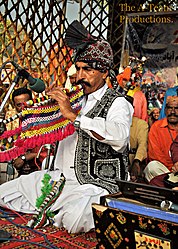music.wikisort.org - Instrument
Alghoza is a paired woodwind instrument. It is traditionally used by Baloch, Saraiki, Sindhi, Kutchi, Punjabi and Rajasthani folk musicians.[2][1] It consists of two joined beak flutes, one for melody, the second for drone. The flutes are either tied together or may be held together loosely with the hands. A continuous flow of air is necessary as the player blows into the two flutes simultaneously.[10] The quick recapturing of breath on each beat creates a bouncing, swinging rhythm. The wooden instrument initially comprised two flute pipes of the same length but over time, one of them was shortened for sound purposes. In the world of Alghoza playing, the two flute pipes are a couple — the longer one is the male and the shorter one the female instrument. With the use of beeswax, the instrument can be scaled to any tune.[11]

 Pakistani musician playing Alghoza | |
| Woodwind | |
|---|---|
| Other names | Alghoze, Jōrhi, Pāwā Jōrhī, Do Nālī, Donāl, Girāw, Satārā or Nagōze[1] |
| Classification | Woodwind instrument |
| Hornbostel–Sachs classification | 421.112 |
| Developed | around 7500 BC in Mesopotamia[2] |
| Musicians | |
Origin

It originated at around 7500 BC in Mesopotamia, it then reached Iran and eventually Pakistan with some modifications.[2] Some Mesopotamian archaic paintings contain a musical instrument very similar to Alghoza.[2]
In Mesopotamia, this instrument was called "Al-Joza", which literally means, "The twin".[2] As it reached Pakistan, the "J" in "Al-Joza" became "gh" and eventually the modified form of this instrument which reached Pakistan came to be known as Alghoza.[2]
References
- "Alghoza". Asian Music Circuit. Archived from the original on 27 February 2017. Retrieved 7 December 2015.
- Chandio, Faraz (September 2, 2018). "CULTURE: THE DYING BREATHS OF THE ALGHOZA". DAWN. Islamabad. Retrieved June 3, 2021.
- Misri Khan Jamali on Pakistan Quarterly via GoogleBooks page 264. Pakistan Quarterly. 1967. Retrieved 9 June 2020.
- Shoaib Ahmed (12 December 2015). "Mystic Music Sufi Festival kicks off". Dawn (newspaper). Retrieved 10 June 2020.
- Yusuf, Zohra (1988). Rhythms of the lower Indus: perspectives on the music of Sindh. Dept. of Culture and Tourism, Govt. of Sindh.
- "An elegy to music". www.thenews.com.pk. Retrieved 2020-07-21.
- "TheNews Weekly Magazine". www.thenews.com.pk. Retrieved 2020-07-21.
- Kaur, Simmypreet (2011-10-01). "ਲੰਮੀ ਹੇਕ ਦੀ ਮਲਿਕਾ ਗੁਰਮੀਤ ਬਾਵਾ" [The queen of the long vocal note]. The Punjabi Tribune (in Punjabi). Retrieved 2013-10-17.
- Majari, Surjit (2010-12-25). "ਰਵਾਇਤੀ ਗਾਇਕੀ ਨੂੰ ਸੰਭਾਲਣ ਦੀ ਲੋੜ" [Need to preserve traditional music.]. The Punjabi Tribune (in Punjabi). Retrieved 2012-05-10.
- Pande, p. 70
- Usman, Maryam (2013-08-26). "Instrumental Ecstasy concert: A retreat into the rhythms of Sindhi classical tunes". The Express Tribune. Retrieved 2015-12-07.
- Books
- Pande, Alka (1999). Folk Music & Musical Instruments of Punjab. Grantha Corporation. ISBN 818582262X.
Другой контент может иметь иную лицензию. Перед использованием материалов сайта WikiSort.org внимательно изучите правила лицензирования конкретных элементов наполнения сайта.
WikiSort.org - проект по пересортировке и дополнению контента Википедии